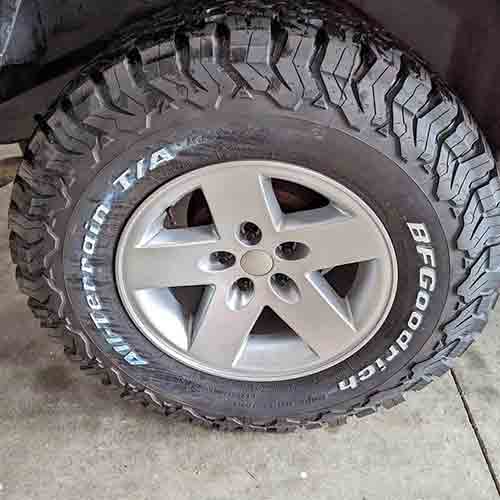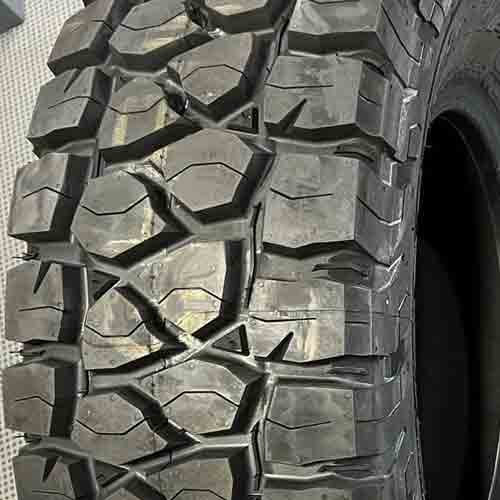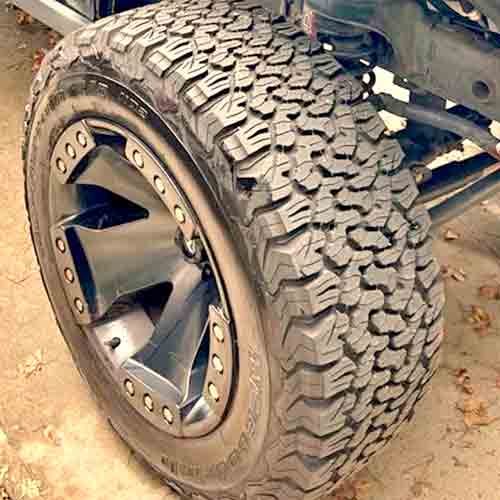These two off-road tires hail from distinct categories: the renowned BF Goodrich KO2 belongs to the all-terrain segment, while the BF Goodrich HD Terrain is typically classified under the Rugged Terrain category. Let’s take a closer look at both these boys.

The BF Goodrich KO2 excels in certain key areas such as dry grip, steering responsiveness, wet traction, and performance on rocks, and dirt-filled roads. Moreover, the tire is also relatively quieter, (as it produces less groove resonance). On the other hand, the BF Goodrich HD-Terrain leads, when it comes to absorbing road vibrations, delivers superior traction on softer terrains, (such as sand and mud), and provides a better handling stability due to its single cap ply, and better optimized shoulder blocks.
Sizes Specs
BF Goodrich HD-Terrain T/A KT comes in total of 31 sizes with following specs.
- Rim sizes: 16 to 22 inches.
- Speed ratings: Q only.
- Load rating: C to F.
- Weight range: 51 to 82 lbs.
- Tread depth range: 18/32″ on all.
- Only branded with M+S, and missing with 3PMSF rating.
Detailed Discussion on HD Terrain tire: https://tiredriver.com/bf-goodrich-hd-terrain-t-a-kt-review/
While the BFG KO2 conmes in 92 total sizes, with following.
- 15 to 22 inches rims.
- Speed ratings: R, S, and Q
- Load ratings range: C to E
- Weight range: 35 lbs to 67 lbs
- Tread depth: 15/32″ on all sizes (except for 4)
- Winter ratings: M+S & 3PMSF
- 50k miles warranty
Detailed Discussion on KO2: https://tiredriver.com/bf-goodrich-ko2-review/.
Outer Construction
The BFG HD Terrain is composed of four primary ribs.

The central two ribs feature (somewhat) interlocking triangular blocks, with numerous offset edges and chamfered sides, creating a network of grooves (running) in various directions.
These grooves house dual stone ejectors, where prominent triangular ones are seen close to the typical ones, (on outer circumferential voids).
Now all blocks/lugs, don’t really carry a lot of features, as you can see from the image (of its tread).
They only come with mere siping slits (through, they are full depth).
The shoulder blocks are pretty squared-off. And they are again very minimal, with only linear siping on them.
Though every other of blocks have lateral notches in them.
But still, you get less aggressive shoulders here, especially when compared to KO2. (And same goes for it’s sidewalls).
Moving to the other tire, the BF Goodrich KO2 shows off with a more compacted up design. Though that only goes for it’s central tread area.

In the middle, there are worm-like blocks, seen with full depth sipes, and notches.
And needless to say, these lugs create a very aggressive web of grooves, where just like the HD Terrain, you again get to see dual stone ejectors.
On shoulders, there are two different kinds of angular cuts, which are pretty gripping.
Moreover, just like it’s counterpart, the outer edges of these shoulder blocks are staggered, though they make bigger “scoops”.
Additionally, you also gete more aggressive sidewalls here too, where lugs are not only thicker, but also covering a greater bead area.
So you get (sidewall flexing) performance with lowered air pressure, and at the same time, durability.
Inner Construction
Tires for rugged terrains must endure harsh conditions. That’s why the treads of such tires are crafted using powerful rubber compounds, fortified with silica, ensuring optimal resistance to cuts.
However, the primary source of durability still comes mostly from the tire’s internal structure.
Now, the BFG HD Terrain gives you a single-layer nylon coating beneath its external rubber layer, supported by two robust steel belts.
And these belts are strategically situated above the tire’s resilient three-ply polyester casing, which safeguards the sidewalls.
On the other side, the KO2 features a robust three-layer polyester lining, enveloped by two steel belts encased in two spirally wound nylon layers.
Thus, on paper, the KO2 appears internally stronger, though overall, both tires are equally durable.
Ride Quality
With flexible outer rubber (of tread), tires are able to soak up the imperfections of the road effectively.
And here, the BF Goodrich HD-Terrain performs better, due to its single cap ply and softer lug composition on top, enabling efficient absorption of road vibrations.
Moreover, the tire also features greater tread depth, 18/32″ on all its sizes, compared to BFG KO2’s 15/32″. This is significant because with more tread depth, there’s more rubber between the bumps and the vehicle.
Furthermore, the BF Goodrich KO2 with its spirally wound nylon gets to add to the ride stiffness, resulting in less efficient bump absorption compared to the HD-Terrain.
Noise
Tire noise is affected by rolling resistance, vibration, and groove shape.
Therefore, it is logical that the BF Goodrich KO2 performs better in this regard. Its compact structure does not produce too much noise in the first place, and its harder rubber produces less resonance, (which is basically the echoing of the generated noise).
On the other side, the BF Goodrich HD-Terrain has a slight disadvantage here, though its noise levels are still acceptable, given its a rugged terrain tire.
It basically manages noise with well-engineered pitch sequencing, where slight rib geometry variations produce different air strike tones on the blocks, canceling each other out to reduce noise.
But yes, of course, its still much louder compared to KO2.
Rugged Terrain Performance
Off-road terrains present a variety of challenges, so let’s explore how each tire performs on different surfaces.
On Sand
Driving on sand requires specific tire characteristics: appropriate air pressure, weight, and tread composition. These factors influence the tire’s ability to float on soft surfaces, which is critical for maintaining traction.
The BF Goodrich HD-Terrain, with its wider grooves and softer composition, provides superior traction on sand because it allows the tire to ‘float’ more effectively.
In contrast, the BF Goodrich KO2 has sharper edges and spirally wound cap plies, making it lighter but less able to provide the same ‘floating’ ability as the HD-Terrain.
On Muddy Tracks
Muddy terrains are particularly challenging, and while all-terrain tires typically have self-cleaning grooves, they often aren’t aggressive enough to handle mud effectively.
The BF Goodrich KO2, with its hook-shaped structure, traps more mud, making it less effective in these conditions.
Conversely, the BF Goodrich HD-Terrain has wider grooves and less sharp edges, which minimizes digging and focuses more on forward movement, a crucial aspect for navigating muddy tracks.
On Rocks
Rocky terrains require a tire with a multidirectional grip and robust sidewalls to prevent overturning, enhance durability, and provide traction even with reduced air pressure.
The BF Goodrich KO2 offers slightly better traction on rocks due to its greater durability, angled sidewall lugs forming biters, and full-depth sipes that open the lugs, enhancing the grip of its hook-shaped blocks and providing a combination of lateral and circumferential traction.
On the other hand, the BF Goodrich HD-Terrain has fewer tread features in the middle, which limits its grip on rocky surfaces.
Dirt Filled Roads
Navigating gravelly roads requires self-cleaning grooves. Tires without stone ejectors and narrow tread voids can become clogged with dirt and stones, reducing traction and increasing damage risk, even with chip-resistant rubber. However, this is not an issue for either tire.
The BF Goodrich HD-Terrain has wider grooves that resist debris accumulation, while the BFG KO2 features dual stone ejectors that serve the same purpose.
Overall, both tires exhibit strengths and weaknesses across different terrains, making the choice dependent on the driver’s specific needs and the most frequently encountered terrains.
On-Road Performance
While off-road capabilities are crucial for rugged terrain tires, on-road performance is equally important as most vehicles will spend a significant amount of time on highways and city streets.
Key aspects of on-road performance include dry directional grip, steering response, and handling stability.
Dry Directional Grip
Dry directional grip refers to the tire’s ability to maintain traction and stability on dry roads. Both the BF Goodrich KO2 and HD-Terrain provide a good balance between stability and traction on dry surfaces, but the KO2 has a slight edge in overall handling.
Its stiffer rubber compound remains firm on the road, providing stability, while its compact central ribs provide more rubber contact with the road, translating to better grip. The full-depth sipes on the KO2 also aid in overall grip by splitting open the blocks.
The HD-Terrain also performs well in this regard, thanks to its shoulder blocks, which lack notches or features that reduce rubber, allowing for satisfactory lateral traction.
Steering Response
Steering response is the tire’s ability to respond quickly and accurately to steering inputs. Although it varies with tire size, the KO2 generally provides better steering responsiveness due to its lighter weight and strong biters on the shoulder blocks, which improve responsiveness while cornering.
However, both the KO2 and HD-Terrain struggle on wet roads; besides hydroplaning, they do not provide enough siping to clear water from their paths, leading to oversteering in the Nitto Ride and understeering in the BFG KO2.
Handling Stability
Handling stability refers to the tire’s ability to maintain its course during dynamic maneuvers, such as sudden lane changes or cornering at high speeds.
Surprisingly, the HD-Terrain offers decent lateral stability on roads, despite being categorized as a rugged terrain tire. Although its wider grooves lead to faster tread wear, its shoulder blocks are optimized for highway stability. They offer more contact with the road as there are no notches, and siping is low.
Additionally, the shoulder blocks are attached to the central blocks with ridges, acting as foundation supports. As a result, the HD-Terrain offers higher speed ratings (up to Q), whereas the KO2 offers up to S.
Wet Performance
The BF Goodrich KO2 notably outshines the HD-Terrain in wet traction, where siping and tread composition are key. The KO2 features interlocking full-depth sipes on all lugs, efficiently picking up water particles. Additionally, its worm-like design effectively resists hydroplaning.
On the other hand, while the BF Goodrich HD-Terrain also resists hydroplaning, its smoother design and lack of full-depth siping hinder efficient water evacuation. Although it effectively channels water through its grooves, the residual water beneath the lugs remains unaddressed due to insufficient siping, a common issue with mud terrain tires.
Winter Performance
When comparing the two tires, the BF Goodrich HD-Terrain’s shortcomings in winter traction become evident. It lacks sufficient biters and its non-full-depth sipes (fewer in number) are inadequate for gripping hard-packed snow, hence it is not marked with the 3-Peak Mountain Snowflake (3PMSF) rating, unlike its competitor.
Conversely, the BF Goodrich KO2, with its 3-rib design in the center and hook-shaped lugs featuring full-depth sipes, can capture snow particles much more efficiently.
Tread Life
Tread mileage refers to the distance a tire can travel before the tread wears down to a level that is no longer safe or legal to drive on. It is a common misconception that tread wear is solely determined by rolling resistance. However, tread depth and composition are also significant factors.
Both the BF Goodrich HD-Terrain and KO2 tires offer similar mileage throughout their lifespan, despite having different characteristics.
The BF Goodrich HD-Terrain has a greater weight and wider grooves, which means the lugs (the raised portions of the tire that make contact with the road) are subject to more pressure, causing faster wear and decreasing fuel economy. However, the HD-Terrain has a greater tread depth, reaching up to 18/32″, which compensates for the faster wear rate, resulting in a similar tread wear life as its competitor.
On the other hand, the BF Goodrich KO2 has a more stable lug formation and a harder compound, resulting in a slower burning rate. However, its tread is shallower, so it reaches the minimum tread depth of 2/32″ sooner than the HD-Terrain.
The 2/32″ tread depth is the legal limit in many places, beyond which it is not safe or legal to continue driving on the tire. A penny can be used to check the tread depth of your tires and determine whether they are still safe to use. If the tread is shallower than the top of Lincoln’s head on a penny, it is time to replace the tire.
Take Home Points
- Construction: Both BF Goodrich KO2 and HD-Terrain tires have comparable durability despite differences in construction.
- Ride Quality & Noise: HD-Terrain absorbs road vibrations better, whereas KO2 produces less noise and resonance.
- On-Road Performance: KO2 has a slight edge in dry grip and steering responsiveness, while HD-Terrain offers good handling stability.
- Wet & Winter Performance: KO2 outperforms in wet traction and snow particle capture, whereas HD-Terrain struggles with water evacuation and gripping hard-packed snow.
- Rugged Terrain Performance: HD-Terrain offers superior traction on sand and mud, while KO2 performs better on rocks and dirt-filled roads.
- Tread Life: Both tires offer similar tread mileage despite different characteristics.